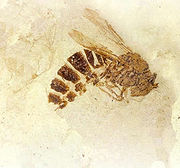
Vespinae
Encyclopedia
The subfamily Vespinae contains the largest and best-known eusocial
wasp
s, including true hornet
s (the genus Vespa), and the "yellowjacket
s" (genera Dolichovespula and Vespula). The remaining genus, Provespa
is a small, poorly-known group of nocturnal wasps from Southeast Asia
. One genus, Palaeovespa
, has been described from the Eocene
fossil record
, from Colorado. Collectively, the group can be found on all continents except Antarctica, and several of these wasps are invasive species
, introduced beyond their native range, and can be major pests.

Eusociality
Eusociality is a term used for the highest level of social organization in a hierarchical classification....
wasp
Wasp
The term wasp is typically defined as any insect of the order Hymenoptera and suborder Apocrita that is neither a bee nor an ant. Almost every pest insect species has at least one wasp species that preys upon it or parasitizes it, making wasps critically important in natural control of their...
s, including true hornet
Hornet
Hornets are the largest eusocial wasps; some species can reach up to in length. The true hornets make up the genus Vespa and are distinguished from other vespines by the width of the vertex , which is proportionally larger in Vespa and by the anteriorly rounded gasters .- Life cycle :In...
s (the genus Vespa), and the "yellowjacket
Yellowjacket
Yellowjacket is the common name in North America for predatory wasps of the genera Vespula and Dolichovespula. Members of these genera are known simply as "wasps" in other English-speaking countries...
s" (genera Dolichovespula and Vespula). The remaining genus, Provespa
Provespa
Provespa is a lesser known genus of Vespidae, made up of a group of nocturnal wasps from Southeast Asia, such as P. barthelemyi and P...
is a small, poorly-known group of nocturnal wasps from Southeast Asia
Southeast Asia
Southeast Asia, South-East Asia, South East Asia or Southeastern Asia is a subregion of Asia, consisting of the countries that are geographically south of China, east of India, west of New Guinea and north of Australia. The region lies on the intersection of geological plates, with heavy seismic...
. One genus, Palaeovespa
Palaeovespa
Palaeovespa is an extinct genus of wasp in the Vespidae subfamily Vespinae. The genus currently contains seven species, five from the Priabonian stage Florissant Formation in Colorado, USA and two from the middle Eocene Baltic amber deposits of Europe....
, has been described from the Eocene
Eocene
The Eocene Epoch, lasting from about 56 to 34 million years ago , is a major division of the geologic timescale and the second epoch of the Paleogene Period in the Cenozoic Era. The Eocene spans the time from the end of the Palaeocene Epoch to the beginning of the Oligocene Epoch. The start of the...
fossil record
Fossil
Fossils are the preserved remains or traces of animals , plants, and other organisms from the remote past...
, from Colorado. Collectively, the group can be found on all continents except Antarctica, and several of these wasps are invasive species
Invasive species
"Invasive species", or invasive exotics, is a nomenclature term and categorization phrase used for flora and fauna, and for specific restoration-preservation processes in native habitats, with several definitions....
, introduced beyond their native range, and can be major pests.


